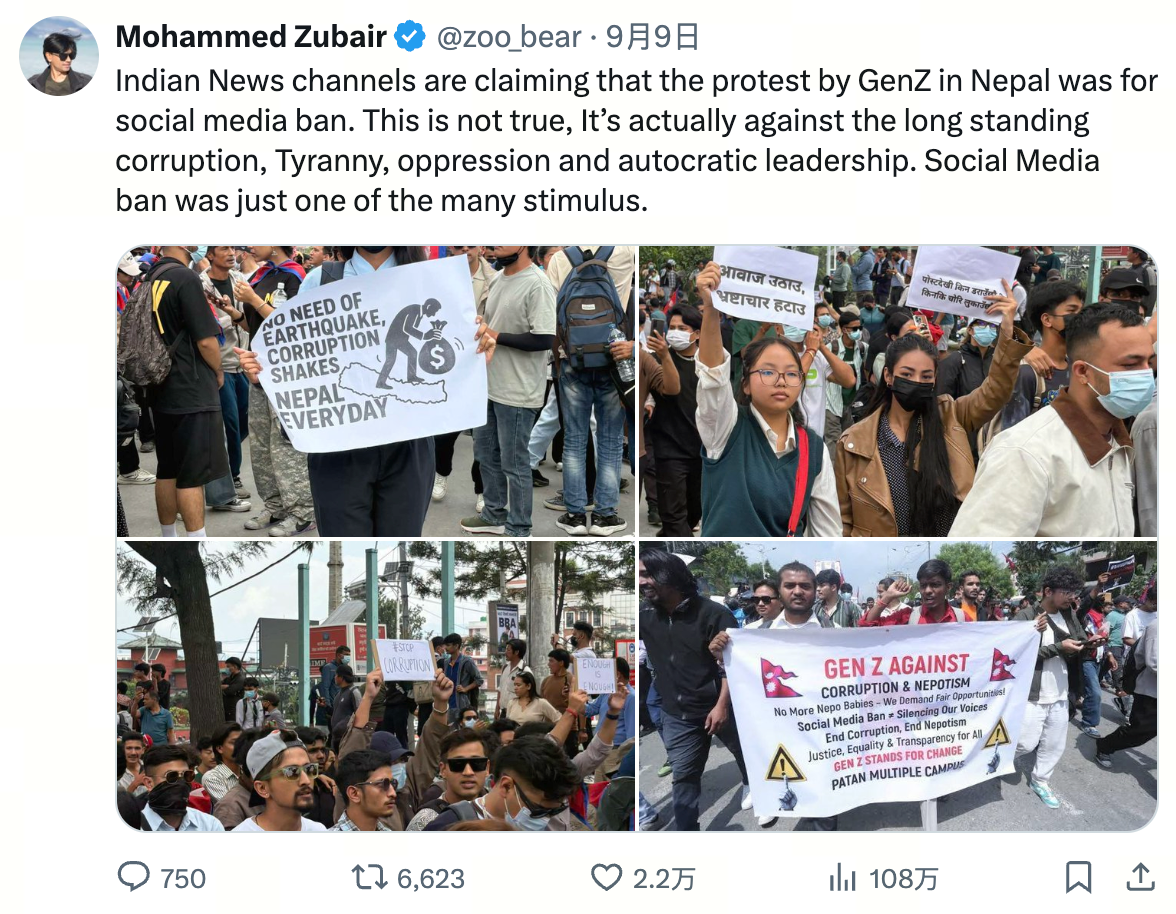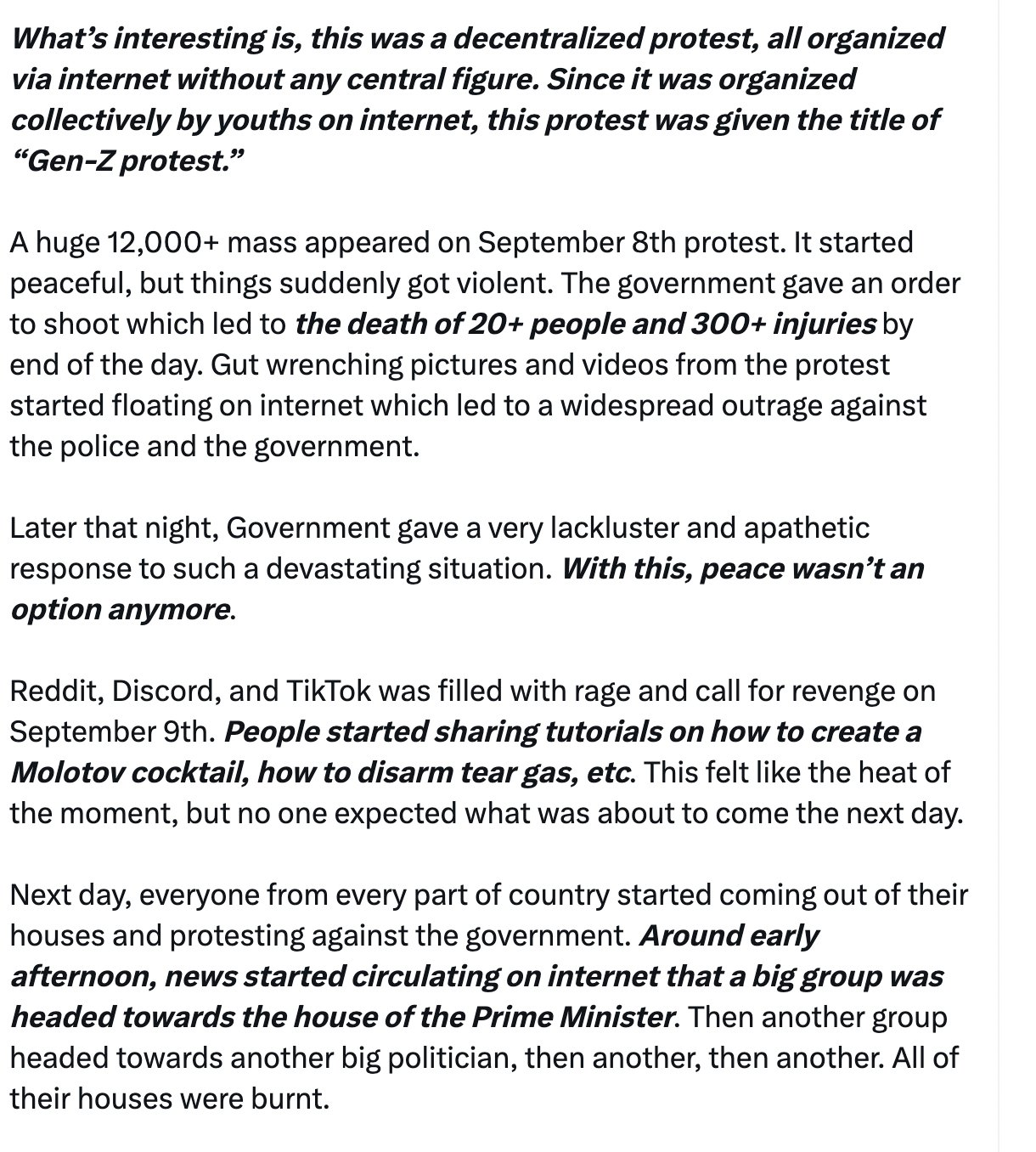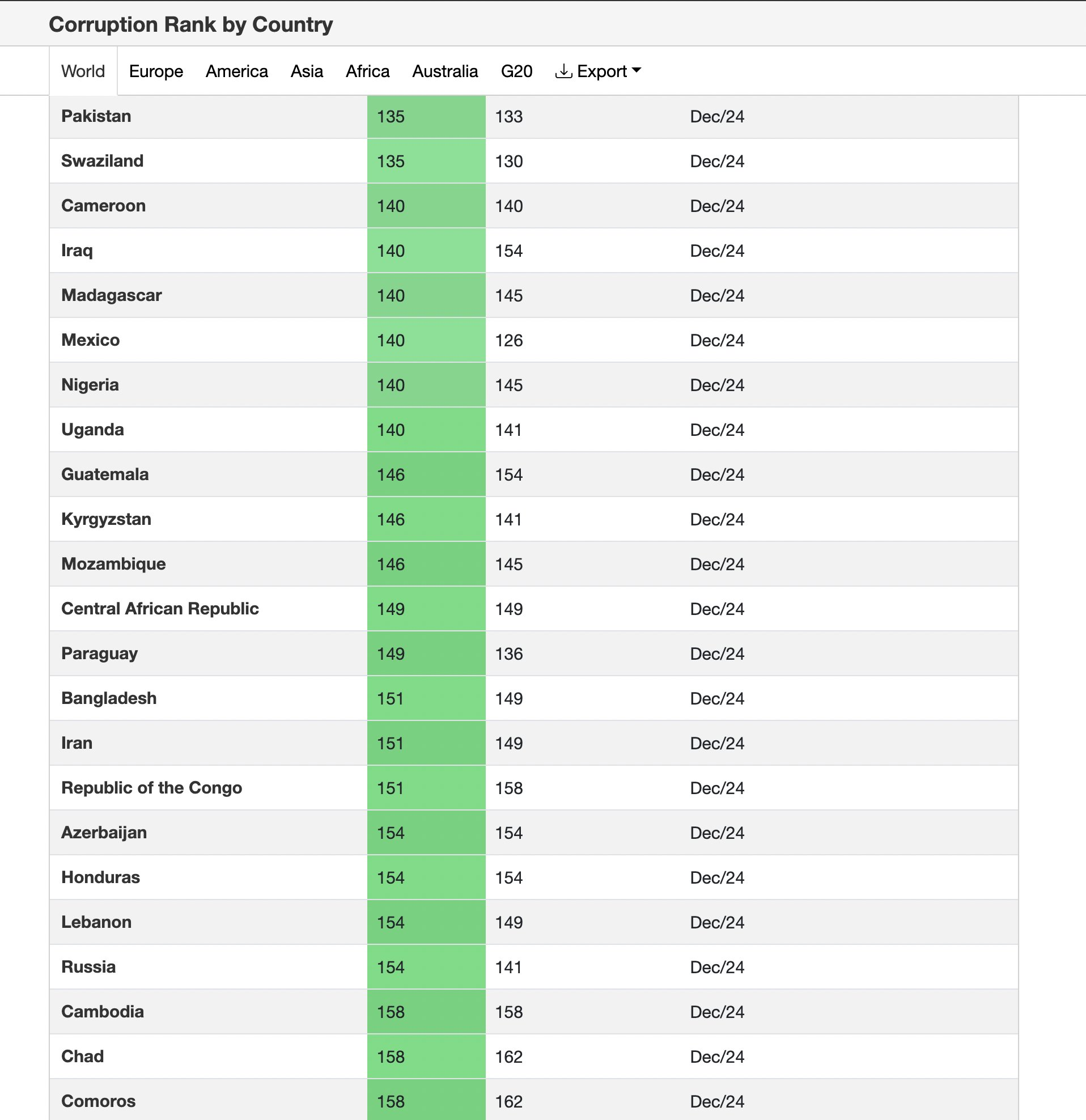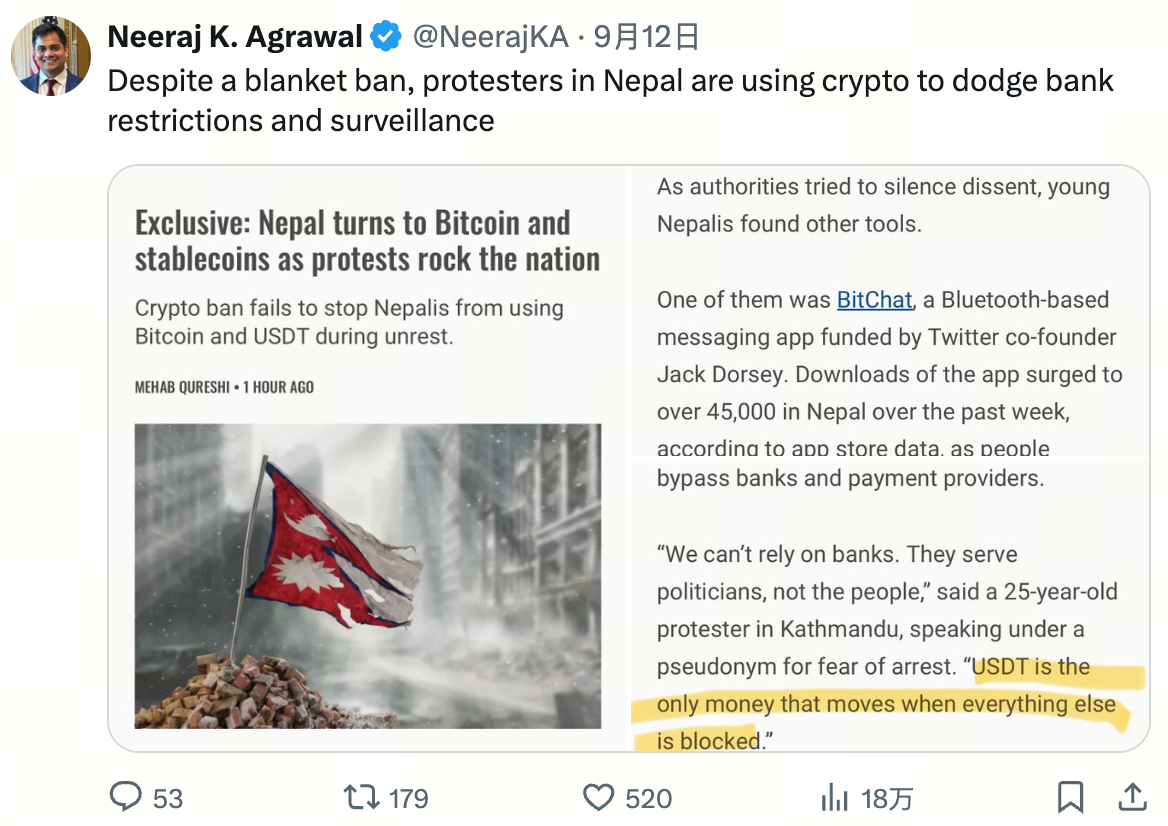La próxima gran memecoin conseguirá tumbar a un gobierno
TLDR: Lo que sucedió en Nepal es solo el comienzo.
La Generación Z en todo el mundo ahora tiene herramientas descentralizadas: Discord, criptomonedas y memes.
La era de la agitación política se extenderá a través de las fronteras más rápido que nunca.
Un movimiento pacífico que comenzó con la juventud nepalí de la Generación Z contra el nepotismo, la corrupción, la desigualdad económica y la prohibición de redes sociales se convirtió en una protesta violenta cuando el gobierno tomó la estúpida decisión de disparar contra manifestantes que protestaban pacíficamente. Diecinueve manifestantes de la Generación Z fueron asesinados y 400 resultaron heridos en ese acto autoritario de la policía bajo la dirección del gobierno en el poder. Eso envió una enorme onda expansiva por todo el país.

El mensaje se difundió rápidamente a través de los canales de Discord, y los jóvenes se reunieron en diferentes ciudades en tiempo récord. El parlamento de Nepal, la infraestructura pública y las casas de los políticos fueron incendiados por los manifestantes. Fue una muestra de rabia masiva en todo Nepal, que obligó al gobierno a bajar la guardia en menos de 24 horas. El primer ministro Oli dimitió, y la Generación Z nepalí ganó esta batalla sin ningún apoyo del partido de oposición. Fue una lucha contra todos los partidos políticos. Era pura energía juvenil expresada en su forma más cruda.
Los jóvenes coordinaron todo el movimiento de manera descentralizada en Discord mientras otras redes sociales estaban prohibidas. Utilizaron criptomonedas para transacciones cuando la banca estaba cerrada. Dirigieron toda la protesta sin depender de un solo líder y establecieron un ejemplo para que todo el mundo lo siguiera.
La naturaleza descentralizada del coraje
La naturaleza descentralizada de esta protesta fue histórica. A diferencia de los movimientos tradicionales que dependen de líderes carismáticos o partidos políticos para organizar y dirigir, la Generación Z de Nepal mostró cómo la tecnología puede aplanar jerarquías y empoderar a miles para moverse en sincronía sin un mando central.

fuente: https://x.com/rachinkalakheti/status/1966314602251301138
Cada servidor de Discord se convirtió en un centro neurálgico, donde fluía la información, las estrategias se creaban colectivamente y las decisiones se tomaban en conjunto. Ninguna persona podía ser silenciada o cooptada porque el liderazgo estaba distribuido. Incluso si algunos canales fueron bloqueados o algunos organizadores arrestados, el movimiento seguía regenerándose. Ese es el verdadero poder de la descentralización: nadie lo posee, pero todos contribuyen a él.
La corrupción es una enfermedad global
La forma en que los políticos nepalíes explotaron el dinero de la gente para su propio beneficio personal es algo que se ve en casi todas partes del mundo. Informes de corrupción han sido expuestos por muchos valientes reporteros en el pasado. Pero la corrupción en las democracias funciona de maneras más sutiles e insidiosas que el autoritarismo descarado.

Desde el sur de Asia hasta América Latina y África, las élites políticas acumulan riqueza generacional a través de contratos opacos, sobornos, monopolios y nepotismo. Drenan recursos destinados al bien público y los redirigen a fortunas personales, dejando a la gente común sobrevivir con las migajas. Los ciudadanos lo saben subconscientemente, pero evitan enfrentarlo porque el sistema normaliza la explotación como "así son las cosas".
La Generación Z de Nepal destrozó esta percepción. Demostraron que se puede poner un espejo frente a la corrupción y exigir responsabilidades, incluso si eso significa quemar los mismos edificios que simbolizan esa podredumbre.
Las redes sociales convertidas en campo de batalla
Esta protesta también estableció un ejemplo de cómo se podría conseguir un enorme apoyo sobre el terreno en tiempo récord utilizando tendencias y campañas en redes sociales. Los hashtags se convirtieron en gritos de guerra, los memes en armas políticas, y las actualizaciones en vivo se transformaron tanto en notas estratégicas como en estímulos morales.
En cuestión de horas, lo que una vez fue descartado como "frustración juvenil en línea" se transformó en un levantamiento callejero coordinado. Es probable que muchas iniciativas similares para derrocar gobiernos ya podrían estar comenzando en fases iniciales en todo el mundo. No todas se materializarán como lo hizo la protesta de Nepal, pero algunas seguramente lo harán. No sería sorprendente si algo como una protesta de la Generación Z ocurre en India en los próximos tres años. Que tenga éxito o no es otra historia, pero habrá un intento.
Las criptomonedas como combustible para la rebelión
Las criptomonedas tendrán un papel más importante en tales protestas, conduciendo a una era de agitación política en el mundo. Los gobiernos controlan el dinero y pueden detener su flujo, pero las personas pueden trascender esas barreras con las criptomonedas.
El dinero siempre es la columna vertebral de cualquier movimiento; sin fondos, las protestas colapsan. La financiación tradicional depende de Organizaciones No Gubernamentales (ONG), partidos de oposición o donantes extranjeros, pero esas fuentes a menudo están comprometidas o bloqueadas. Las criptomonedas ofrecen un canal paralelo: rápido, resistente a la censura y sin fronteras.
Cuando un equipo que inicia una protesta a nivel nacional comparte un manifiesto claro, incluso podrían lanzar una criptomoneda meme. Esa moneda no sería solo una herramienta de recaudación de fondos, sino un símbolo cultural. Cada operación con la moneda se convierte en un micro-voto de confianza, cada aumento de precio en una expresión de energía compartida. Las personas que compran la moneda seguirían impulsando la protesta en las redes sociales en todos los frentes, eventualmente generando más atención, lo que crearía más volumen de operaciones. Esto, a su vez, empujaría el precio hacia arriba.
El equipo detrás de la protesta podría seguir compartiendo actualizaciones desde el terreno, que actuarían como catalizadores para el precio de la moneda. Imagina a alguien en Nueva York, Berlín o Tokio viendo transmisiones en vivo de protestas mientras posee una criptomoneda meme vinculada al movimiento: la conexión emocional y financiera se fusionan en una sola. Sin dinero, las protestas no pueden sostenerse por mucho tiempo, y las criptomonedas meme podrían ser la forma más innovadora de combinar financiación con visibilidad.
El hambre económica detrás de la rabia
Incluso en Nepal, la gente protestó porque ganaban menos dinero que los hijos de la élite. El dinero fue el motivador no expresado, el motor silencioso detrás de la rabia. Necesitan dinero para vivir, necesitan comodidad y seguridad, y lucharon por ello.
Pero, ¿la protesta de Nepal resolvió alguno de estos problemas? Es cuestionable. A corto plazo, podría parecer que tienen esperanza de una vida mejor y más oportunidades cuando un nuevo gobierno presente un plan. Sobre el papel parece fácil. Pero, ¿puede la Generación Z realmente ejecutar y crear riqueza para la mayoría de los ciudadanos? Es difícil. Requiere experiencia, planificación, estrategia y un valor extremo.

Aun así, si las criptomonedas encuentran un camino en el país y transforman la economía del turismo, podrían terminar creando más formas de ganar dinero. Podrían ahorrar en tarifas de intermediarios y ganar más al proporcionar servicios turísticos de manera peer-to-peer (entre pares). Si todo el país avanza hacia el intercambio y la comunicación peer-to-peer, podría ahorrar entre un 10% y un 50% en costos de intermediarios y pérdidas por corrupción. Ese ahorro, transferido a la gente de Nepal que impulsa esta economía, podría ser un verdadero cambio de paradigma.
El futuro de las protestas
Lo que sucedió en Nepal no es una historia aislada. Es el capítulo inicial de una nueva era: una era de agitación política donde la juventud se levantará, no a través de instituciones tradicionales, sino a través de sistemas descentralizados, canales de criptomonedas y economías peer-to-peer.
En los próximos cinco años, se intentarán muchas protestas similares en todo el mundo. Algunas fracasarán, pero otras sacudirán gobiernos enteros. Y detrás de muchas de ellas, las criptomonedas serán el combustible invisible: financiando movimientos, manteniendo viva la comunicación y creando economías paralelas cuando los estados cierren los canales oficiales. Los sistemas peer-to-peer no serán solo herramientas de conveniencia, sino armas de resistencia.
La Generación Z de Nepal mostró al mundo que el coraje, la coordinación y la tecnología pueden unirse para cambiar la historia de la noche a la mañana.
La verdadera pregunta es: ¿qué país será el próximo?
Descargo de responsabilidad:
- Este artículo es una reimpresión de [hmalviya9]. Todos los derechos de autor pertenecen al autor original [hmalviya9]. Si hay objeciones a esta reimpresión, póngase en contacto con el equipo de Gate Learn, y lo gestionarán con prontitud.
- Exención de responsabilidad: Las opiniones y puntos de vista expresados en este artículo son únicamente los del autor y no constituyen ningún consejo de inversión.
- Las traducciones del artículo a otros idiomas son realizadas por el equipo de Gate Learn. A menos que se mencione, está prohibido copiar, distribuir o plagiar los artículos traducidos.
Artículos relacionados

Las 10 principales plataformas de comercio de monedas MEME

¿Qué es Moonshot? Todo lo que necesitas saber sobre Moonshot

Revisión de los diez mejores Bots de memes

¿Qué es Fartcoin? Todo lo que necesitas saber sobre FARTCOIN

Cómo encontrar nuevas memecoins antes de que se vuelvan virales
